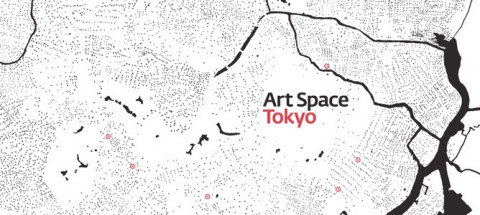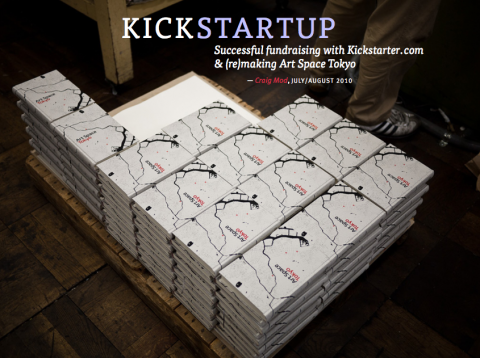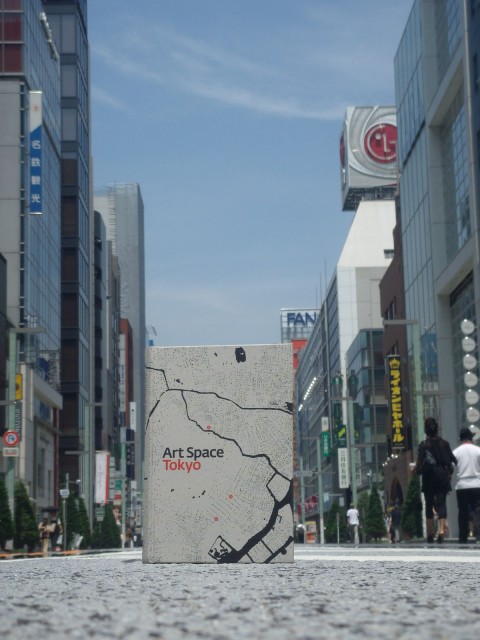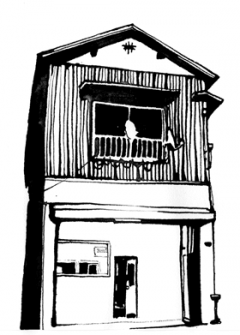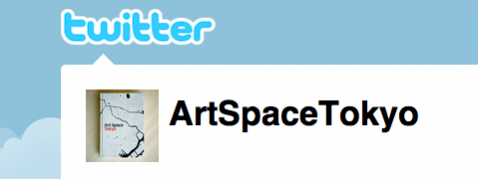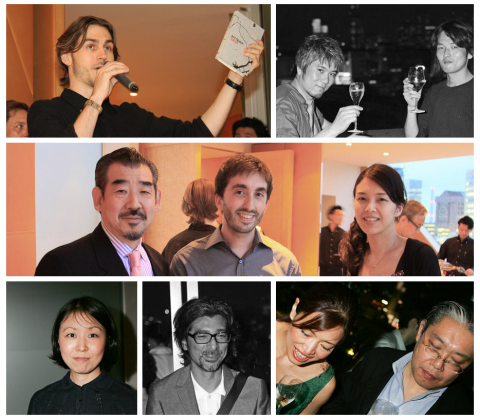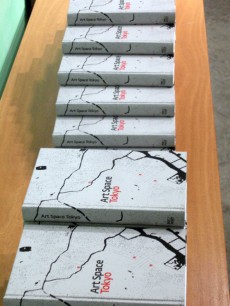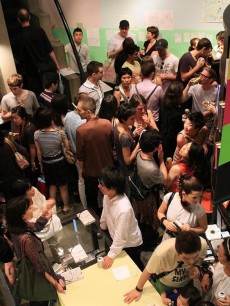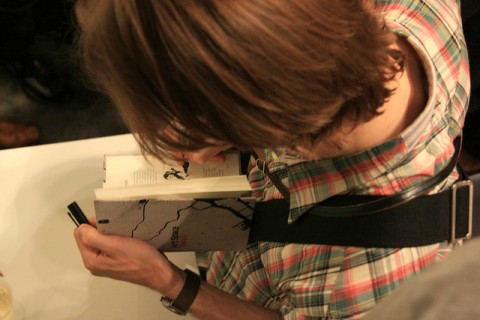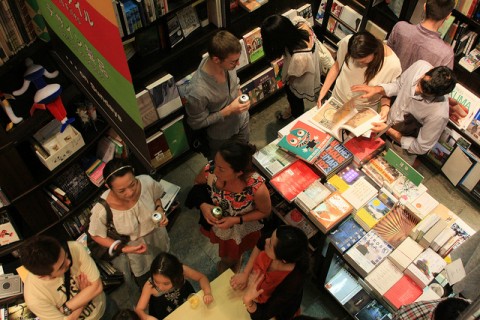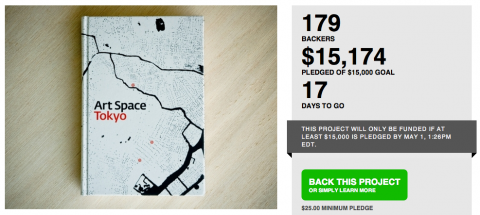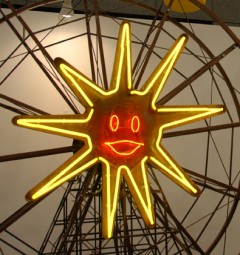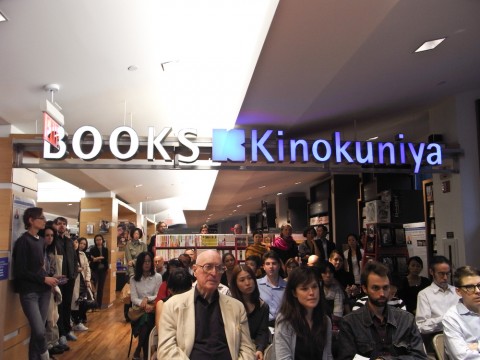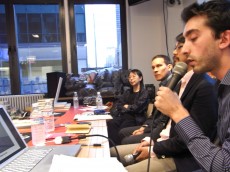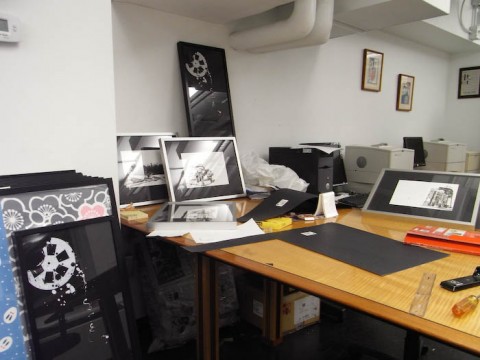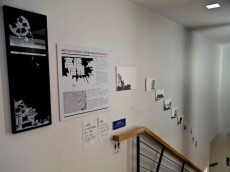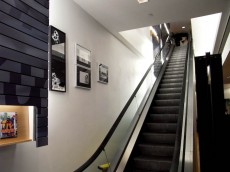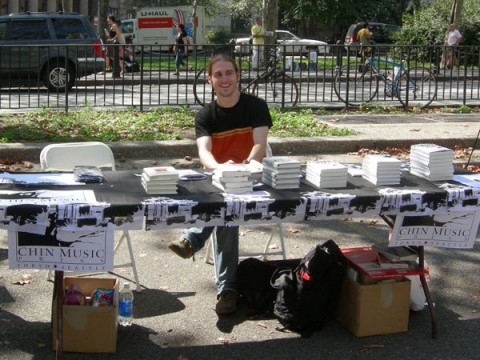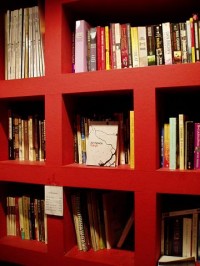AST News
Sayonara to the Art Space Tokyo Blog
After four years of running the Art Space Tokyo blog, it’s time to bring it to a quiet conclusion.
Activity on this blog has ebbed and flowed over the years. At the beginning we regularly posted reports and reviews, but after a year or two we became busier and busier. From 2009 onward, I usually only had time to post monthly round-ups of links to other people’s articles on Japanese art. Even though I only did them once a month, they were a completely tedious chore, but I was driven by hope that in the long term they would be a valuable resource: a centralized point of reference for what people were writing about Japanese art in the early 21st century. But nowadays I want to focus on other projects and not become bound to something merely for the sake of doing it.
Art Space Tokyo has been one of the most rewarding projects Craig and I have ever worked on. From mid to late 2007, we trekked the city in search of its most unusual galleries and museums and we came to know some of the curious characters who keep the Tokyo art world ticking along. In early 2008, we bound their stories into a book that we envisaged as a work of art in its own right, and we were unbelievably lucky to have it illustrated by one of our favorite artists—the gifted and prolific Nobumasa Takahashi.
Though the book bucked the trend of how the Tokyo art world prefers to present itself (something I wrote about in this essay), the reaction was overwhelmingly positive from the outset. We have met so many people for whom the book has been an invaluable gateway to the Tokyo art world, which can be so hard to figure out when you don’t know where to look.
We were stunned when the first (albeit small) print run was sold out within a year of publication. Without any great expectations, in May 2010 we launched a Kickstarter campaign to raise $15,000 for a reprint and the development of a digital version. Back then, Kickstarter was a completely new model of fundraising, so you can imagine our disbelief as we watched a torrent of contributions push us well past our goal and bring in $24,000. Again, to our backers: thank you, thank you, thank you. We will never forget the buzz at the relaunch party we held at the Watari Museum of Contemporary Art nor the rare spectacle of almost every major figure in the Tokyo art world gathered in one room at TODs Omotesando.
Our experience with Kickstarter prompted Craig to write Kickstartup, the first thorough examination of what makes a successful Kickstarter campaign. These days, you have to pull in a few-million-dollars’ worth of microfunding to catch anyone’s attention, but if you haven’t read Craig’s essay already, it’s worth it to remember what the climate was like back then—only two and a half years ago. From then on, Craig wrote more and more about the state of digital publishing. Books in the Age of the iPad (2010), Post-Artifact Books and Publishing (2011) and Subcompact Publishing (2012) are all essential reading. In only four years, the landscape of digital publishing has shifted so much, and I continue to be humbled by the clarity and reason that Craig brings to a still-nascent and contentious discourse.
Although it took us longer to bring it to you than we originally hoped, in the fall of 2012 we finally launched the promised digital versions of Art Space Tokyo. In keeping with the principle of “pointability” that Craig explains in his accompanying essay Platforming Books, the entire contents of Art Space Tokyo are available on read.artspacetokyo.com. Furthermore, this website offers a greatly expanded timeline of events in the Japanese art world since 1945, as well as extensive appendices of resources on the Japanese art world. Even if it’s only on an occasional basis, I will continue to update the timeline and appendices, and use @ArtSpaceTokyo as a simple way of drawing attention to things that are happening in the world of Japanese modern and contemporary art.
Looking back at the Japanese art world in the past four years, what has changed? In terms of Art Space Tokyo’s function as a guidebook, it is inevitable that its contents will gradually go out of date. Already, Nakaochiai Gallery shut its doors, Project Space Kandada closed and was reborn as 3331 Arts Chiyoda, 101Tokyo Contemporary Art Fair didn’t return after its second year, and Shinwa Art Auction no longer holds significant contemporary art sales in Japan. But I’m reassured by the thought that even if none of the institutions or individuals in Art Space Tokyo are active in 30 years from now, the book’s interviews and essays retain an enduring value as a historical record of the Japanese art world at the end of the 2000s.
In terms of the Japanese art world in general, it is hard to say what changes have taken place in the past four years. In the preface to the second edition I wrote, “…the recession, which caused hundreds of galleries to shut down in other countries, has not affected Tokyo’s art world to the same extent. There was no bubble in the Japanese art market in 2008, so nothing really burst.” While that remains true, now that more time has passed I do detect a more fundamental change than I had previously noticed. In the years before I left Tokyo for New York at the end of 2008, I remember there being a distinct sense of optimism that contemporary Japanese art might just be on the cusp of renewed recognition and that the tepid Japanese art market could only get stronger. However, having returned to Tokyo six months ago, there seems to be an underlying feeling of tired resignation to the status quo. It is understandable: after more than two decades of economic stagnation, the latest global recession is painfully familiar to the Japanese. Moreover, the catastrophic earthquake, tsunami, and nuclear contamination that ensued have all raised serious questions about the government’s competence and honesty, instilling genuine feelings of fear about this country’s future. It is still too early to say how the current climate is affecting Japanese artists, but it isn’t hard to imagine that in the coming years their work might become more cynical.
On a more positive note, there has been a global surge of interest in postwar Japanese art, particularly in the United States. In the past two years, there has been a slew of major museum exhibitions: most notably Tokyo 1955–1970: A New Avant-Garde at the Museum of Modern Art, New York; and Gutai: Splendid Playground at the Guggenheim, New York, opening on February 14. Commercial galleries have also been crucial to this renewed momentum. In New York, Hauser & Wirth recently held A Visual Essay on Gutai and for several years McCaffrey Fine Art has been putting on solid solo exhibitions of Hitoshi Nomura, Kazuo Shiraga, Sadamasa Motonaga, Jiro Takamatsu, and Noriyuki Haraguchi. In Los Angeles, Blum & Poe’s survey Requiem for the Sun: The Art of Mono-ha last February was instrumental to putting Mono-ha back on the map, and later in the year it was followed by a solo exhibition of Kishio Suga. Susumu Koshimizu’s solo show will start on February 23.
Though this activity is mostly taking place in New York and LA, there have been some crucial shows in Japan: a retrospective of Atsuko Tanaka at the Museum of Contemporary Art, Tokyo; Gutai: The Spirit of an Era at the National Art Center, Tokyo; 1968–1982: The 70s in Japan at the Museum of Modern Art, Saitama; and Jikken Kobo – Experimental Workshop at the Museum of Modern Art, Kamakura.
Frankly, the timing of all these developments is an incredible blessing for me, as my original field of specialization was postwar Japanese art, with particular emphasis on Mono-ha. I’m now working for Blum & Poe as the director of their forthcoming Tokyo space, details of which will be made public in the coming months. In the meantime, there is a huge amount of archival work that has to be done for the Mono-ha artists. This is what I am focused on these days. Likewise, Craig is cooking up all kinds of new things.
So, with a lot of nostalgia about the creation of Art Space Tokyo and pride about its life in the wild, Craig and I want to say once more how thankful we are to all our readers and supporters. We wish you a very happy 2013 and hope you make amazing books!
If you want to keep up with what Craig and I get up to, it’s all at craigmod.com and ashley.rawlings.com.
Reflections on the Making of Art Space Tokyo
This week, Craig and I have been talking entirely about the creation of the digital editions of Art Space Tokyo. His essay, “Platforming Books,” is the go-to point of reference for how he envisioned adapting the book and what he thinks are the core principles that should shape digital publishing.
By coincidence, I was going through some archives and unearthed this essay that I wrote in 2010, “From Tokyo to New York: The Geographies and Narratives that Shape Two Art Scenes.” It was originally commissioned by the Tokyo Artpoint Project, an inititative run by the Tokyo Metropolitan Government. It feels like a good time to republish it here, as it goes into much more detail than our prefaces to the 2008, 2010 and 2012 editions about the editorial imperative I felt while making the book.
---
From Tokyo to New York: The Geographies and Narratives that Shape Two Art Scenes
Mapping the Tokyo Art Scene
In early 2007, Craig Mod, a Tokyo-based web entrepreneur and publisher, approached me about making a guidebook to Tokyo’s art scene. From the outset, we wanted to avoid the typical, comprehensive A–Z format and create something more personal, so we decided to focus on 12 of the most architecturally and historically interesting museums and galleries. The idea was that the first-time visitor should feel rewarded by the space itself, even if they don’t enjoy the exhibition. We wanted to help people discover the best of Tokyo’s architecture, from stark and innovative concrete edifices to ramshackle wooden warehouses. And instead of documenting these with glossy photographs, we commissioned the extremely gifted artist Nobumasa Takahashi to illustrate the book with stunning black-and-white ink drawings.
The next key objective was to shine a light on the histories of these places. In addition to location maps and details about opening hours, we wanted to develop a narrative map of the Tokyo art scene. To do this, I interviewed each space’s director or curator, discussing topics that ranged from how their spaces came into being to what they look for in contemporary art and where they think the Japanese art scene stands in relation to other countries in Asia and the West.
Since we were eschewing the comprehensive A–Z format, it was also very important to present a fair cross-section of the art scene. The focus on architecturally and historically interesting spaces helped divert our search away from the most obvious, well-known venues, and led us to some lesser-known nonprofit initiatives and foreigner-run galleries. The book also includes institutions that focus on architecture, design and anime. Finally, to cover issues that are not contained within the realm of institutions, we commissioned essays from several Tokyo-based art world figures, who wrote about topics ranging from the syntax of Tokyo’s graffiti to the dearth of art criticism in Japan. Thus, Art Space Tokyo was born.
The Making of the Book
Craig and I began our research in May that year. At the time, I was working as a translator and editor for Tokyo Art Beat, a bilingual website that lists all the art and design spaces in the city, as well as all the exhibitions they hold. I knew that there were more than 500 art venues in the city―not only galleries and museums, but nonprofit initiatives, rental spaces, university museums, art cafés, art spaces within department stores, fashion boutiques and community centers. Even from the beginning, we had a good idea of most of the spaces we would feature in the book, but we wanted to visit as many potential alternatives as possible.
Over the following couple of months, once or twice a week, Craig and I made shortlists of galleries in each area of Tokyo and cycled the length and breadth of them in search of the 12 most inspiring spaces, visiting more than 200 in all. Given that Tokyo has very few street names and most addresses are found by a hermetic system of numbers, the navigation of the city’s art world is a particularly topographical experience. When you know Tokyo well and you have visited a gallery several times, its location becomes embedded in your physical memory. You turn corners instinctively, allowing yourself to be guided by low-key landmarks: a right-turn at the shuttered tobacco store, followed by a left at the red-and-white striped barricade, and then a short ride down a narrow alleyway of pristinely parked bicycles. Unlike New York’s Chelsea, Lower East Side and Williamsburg neighborhoods, or Beijing’s 798 and Caochangdi districts, there are very few places in Tokyo that could be considered “gallery areas.” Tokyo’s art scene, spread out in this infinite maze of streets, can be totally baffling to the first-time visitor.
Sometimes the first-time foreign visitor even baffles the gallery. I remember walking into one particularly old-school, conservative space in Nihombashi only to see the owner stagger back a few paces in open-mouthed astonishment at our arrival. Such overt reactions of surprise are certainly the exception rather than the rule in Japan’s most cosmopolitan city, but there is nevertheless a certain feeling of provincialism that one feels in Tokyo’s art scene. This is not to suggest that provincialism is a wholly negative characteristic, nor to imply that it is inherently better to be a highly commercial, international art hub like Los Angeles, New York, London, Sydney or Beijing. But it does raise questions about Japan’s place in the global art world.
As China, India and Southeast Asia’s art scenes have boomed in recent years, against a backdrop of a somewhat tepid domestic scene, Japanese artists and curators have begun to reconsider their role and relevance in Asia. Such reflection is constructive, but the sad thing was that I occasionally encountered hints of an inferiority complex among them, a sense of anxiety that Tokyo’s galleries should be more “on a par” with their more commercially vibrant counterparts elsewhere in the world. I noticed how Tokyo’s most powerful galleries paid close attention to the construction of Tokyo’s self-image, collectively taking pains to project coherence, confidence and credibility into the international market. In a slightly simplistic nutshell, the narrative is as follows: though Tokyo has had a commercial contemporary scene since the 1950s, galleries that are “on a par” with those in the West only emerged in the 1990s (coinciding with the global interest in Yoshitomo Nara, Takashi Murakami and his anime-derived Kaikai Kiki/Superflat aesthetic); by the mid-2000s, the staff of those galleries began open their own spaces, creating a new generation. Altogether, we’re talking about no more than 30 commercial venues.
Tokyo’s art scene is still small enough for many of these galleries to operate more as allies than rivals. The positive side of this was that there was refreshingly little politics to negotiate when Craig and I approached venues about taking part in AST. Most wanted to know which other galleries and museums would be featured, and many remarked on how unconventional the lineup was; the focus on architecturally and historically distinctive spaces excluded many of the key players in the aforementioned narrative. However, everyone recognized that AST was a much-needed English-language guide, and some even expressed regret that it had taken so long for anyone to come up with such an initiative.
And yet, while the book was very well received when it was published, one negative comment about it stuck in my mind. A young gallerist whose space was not featured in the lineup said she was uncomfortable about its juxtaposition of top-tier commercial galleries with lesser-known spaces; she felt it should have focused more on the linchpins of the 1990s and 2000s. I guess she was too wrapped up in those politics to see the point of AST. I believe that those galleries can take care of themselves; I certainly made sure to document their role within the book, but it is precisely their increasingly dominant narrative that I wanted to counterbalance before it becomes entrenched. There is more to Tokyo than what they do.
Tokyo as seen from New York
Nearly two years after AST was published, I find myself living and working in New York, observing Tokyo’s art world from the outside. In early 2009, I moved here to work as an editor at ArtAsiaPacific magazine. Though along with Australia, China and India, Japan is considered one of the contemporary art giants among the 67 countries and territories covered in AAP―ranging from Turkey to the Pacific Islands―it feels somewhat lost in the fray. While obtaining information on the Japanese art scene is certainly much easier than finding out what artists are doing in Turkmenistan, Bhutan and Niue, there is the strange feeling that Japan is disproportionately remote. I know exactly where to find the information about Japanese art online, but somehow it feels more like fulfilling a niche interest than it should. Many people I meet in New York are fascinated by Japanese contemporary art, and yet few know much about it. The more Tokyo can do to raise its profile and diversify its English-language self-representation―at home and abroad―the better.
It goes without saying that in contrast to Tokyo, the geography of the New York art scene is far more efficient. The simple logic of most of the city’s street numbering means there is little difficulty in finding any museum or gallery, especially when they are so densely concentrated in a handful of areas. But more importantly, information is provided in abundance: exhibitions are well publicized and documented, both in print and online. It is New York’s culture of informational openness that Tokyo should seek to emulate, not its social grandstanding. In that respect, New York is almost too efficient for its own good. The relentless competitiveness of social networking, particularly in Chelsea, is exhausting and for the most part uninteresting―it might advance some people’s careers, but does it advance the art and the surrounding discourse? The great thing about Tokyo’s art scene is that it’s not like anyone works in it to accumulate massive wealth and power, so it is largely driven by a sincerity and integrity that is not always easy to find over here.
With that in mind, it is an interesting time to be living here. Though overall the art market thunders on in spite of the recession, and sales continue to be made at prices far above Tokyo’s, New York’s global relevance is in gradual decline. No doubt it will continue to remain important and influential, but with the growth in prominence of contemporary artists from all other parts of the world, and a proliferation of art fairs, biennials and triennials across the globe―particularly in the Asia-Pacific region―there have never been so many inspiring, alternative opportunities to make one’s mark elsewhere, and on one’s own terms.
Art Space Tokyo — Now Available on All Major Digital Platforms
( 日本語は下にあります)
Art Space Tokyo, your intimate guide to the Tokyo art world, is now available on all major digital publishing platforms. Buy it for iPad, Kindle, or Nook. Or start reading it online.
Originally published in 2008, Art Space Tokyo focuses on twelve of the city’s most architecturally and historically distinctive museums and galleries, revealing the stories that brought these spaces to life.
Among them are a warehouse built in 1868 that has survived a major earthquake and firebombing, a beautifully maintained early 20th-century Japanese estate-turned-museum, a renovated public bathhouse, a couple of sleek examples of postmodern architecture, and an anime-inspired castle in the woods. Some have longer histories than others, but each has a story worth reading about.
But AST is more than just an ordinary guidebook. It brings together the voices of key figures in the Tokyo art world—twenty interviews with curators, gallerists, collectors, art-fair directors and auction experts as well as six essays on topics ranging from Tokyo’s art scene in the 1990s to the vernacular of Tokyo’s graffiti.
Lovingly illustrated by Nobumasa Takahashi and bound with a silkscreen cover, the printed edition of AST is a celebration of the physical object.
Now able to expand beyond the limits of the page, the digital version of Art Space Tokyo is a growing online resource. We’ve divided AST’s massive collection of content into its constituent types: Spaces, Interviews, and Essays. We’d also like to draw your attention to the significantly expanded Timeline and Appendices.
You can read more about the process of making AST digital in Craig Mod’s essay Platforming Books.”
Our hope is for this to be a valuable and ever expanding resource for anyone—not only specialists, but those with even a passing interest in Japanese art or Tokyo.
CRAIG MOD & ASHLEY RAWLINGS, New York / Tokyo, August 2012
東京のコンテポラリーアート業界のガイドブックArt Space Tokyo のデジタル版を発表いたします。今日から、iPad、KindleまたはNookでご購入いただけます。また、ウェブサイトでも本の内容をお読みいただけます。
2008年に出版されたArt Space Tokyoは、その歴史や建築の面白さから選ばれた東京の12軒の美術館とギャラリーを紹介するガイドです。本書はそれぞれのアートスペースの原点を感じさせてくれるものです。
掲載されている12軒の中には、大震災と大空襲を生き抜いた1868年建ての倉や、昭和初期の邸宅を改築した美術館、200年の歴史を持つリノベーションされた銭湯、ポストモダンの新築美術館、森に潜むアニメのようなお城など多くの魅力的なスペースがあり、それぞれ歴史の長さは違いますが、どこにも魅力的な物語が散りばめられています。
ただ、Art Space Tokyoは典型的なガイドブックだけにはとどまらず、東京のアート界の様々な方の声を紹介する本でもあります。キュレーターや、ギャラリーオーナー、コレクター、アートフェアのディレクター、オークションの専門家との20のインタビューと共に、90年代の東京アートシーンや東京のグラフィティなどについての6つのエッセイも一緒に掲載しています。
高橋信雅の素晴らしいイラスト、シルクスクリーン印刷の美しい表紙など、印刷版のArt Space Tokyoは、手にとっていただいた時にはじめて分かる本としてのモノの良さを追求したつくりになっています。
一方、ページの枠を飛び出すことができるデジタル版のArt Space Tokyoはこれからますます拡大していくオンライン上のリソースとなっていきます。Art Space Tokyoの膨大な内容をカテゴリー(スペース、インタビュー、エッセイ)に分けました。また大きく更新された年譜とアペンディクスにもご注目下さい。
Art Space Tokyoをデジタル化する課程について詳しくは、クレイグ・モッドが執筆したエッセイ「Platforming Books」をお読み下さい。
私たちは、Art Space Tokyoが美術専門家に限らず、アートや東京にちょっとでも興味がある多くの皆様にも役立つリソースになることを望んでおります。
CRAIG MOD & ASHLEY RAWLINGS、ニューヨーク/東京、2012年8月
Hitting the Street
It always puts a smile on my face when a reader gets back to Craig and me with details of the unexpected encounters they had during their Art Space Tokyo travels.
John Pull and his partner Harry recently told us about meeting Ginji, the resident cat at Gallery éf who apparently has his own blog. And who doesn’t love cat videos?
John also sent us this awesome photo of Art Space Tokyo on the streets of Ginza, home to two of the book’s art spaces. If you’re in the neighborhood, be sure to stop by Tokyo Gallery + BTAP and Gallery Koyanagi, two of the best galleries among dozens in the area.
Do you have any Art Space Tokyo stories to tell? Any images of the book in the Tokyo cityscape? Send them to !
Nakaochiai Gallery Closing
I’m sorry to report that after six years of exhibitions, Nakaochiai Gallery is holding its closing party on November 27.
Having long been involved in art projects all over Tokyo, the owners, Julia Barnes and Clint Taniguchi, have decided to move their home to Mejiro and continue their art activities without a permanent gallery space.
The only other featured gallery to have closed in the two and a half years since Art Space Tokyo was first published is Project Space Kandada, run by the nonprofit artist collective commandN. However, like Nakaochiai they were not shutting down their operations but were relocating and expanding them elsewhere, at their new initiative, the 3331 Arts Chiyoda center.
When Craig and I chose the 12 spaces to feature in the book, we did try to choose those with longevity. After all, we were looking for some of the most architecturally and historically distinctive galleries and museums, so the fact that most of them are located in striking, often purpose-built buildings makes them less likely to relocate.
But it was inevitable that some would, and Project Space Kandada and Nakaochiai were the two that we suspected would be most likely to do so. But it’s important to remember that we also chose these spaces because of the fascinating neighborhoods they are in. We want our readers to continue to explore the secondhand bookstores of Kanda and the old-world residential backstreets of Nakaochiai. Keep wandering!
A Moment With Craig Mod
Art Space Tokyo publisher Craig Mod talks to Graham CopeKoga about his philosophy of bookmaking while in London for the DO lectures, held in Wales, where he spoke on September 19th.
The video contains previously unseen footage of the second edition of Art Space Tokyo in mid-production at the printers in Tokyo.
Art Space Tokyo on Twitter
Sometimes the obvious hits you waaaaay later than it should have.
Until today, Art Space Tokyo had no Twitter account.
But now we do! So please follow us!
We’ll continue to use the AST blog to post monthly round-ups of links to articles on Japanese contemporary art as well as other news items, but through Twitter we will definitely offer more up-to-the-minute updates about the Japanese art scene.
Art Space Tokyo’s July Party at the TODs Flagship Store
Following our party at the Watari Museum of Contemporary Art, we celebrated the relaunch of Art Space Tokyo in style at TODs.
The party was full of people featured in AST, but given the book’s focus on a specific set of venues, it was fantastic to see so many artists, gallerists, curators, collectors and editors from the broader Tokyo art scene in attendance.
You can check out the full photo report on the Pre-Post website.
AST’s July Party at the On Sundays Bookstore in the Watari Museum of Contemporary Art
On July 3, Craig and I held the first of two events to celebrate the printing of the second edition of Art Space Tokyo.
Kisato Kusano, the owner of the renowned On Sundays bookstore in the basement of the Watari Museum of Contemporary Art (one of the 12 spaces featured in the book) generously offered us the chance to use the space so we could bring in a big bad crowd of book lovers for an evening of free beer, wine and sake.
Thank you to everyone who came! It was great to see you out in force!
Photos by Xin Tahara and Ashley Rawlings.


Left: The stunning exterior of the Watari Museum.
Right: Kusano-san laying out copies of Art Space Tokyo.
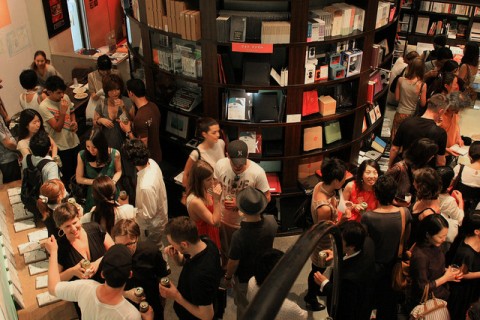
The On Sundays bookstore quickly filled up with supporters.

AST editor Ashley Rawlings talking to Megumi Matsubara from the Tokyo-based architectural office “Assistant.”

Kisato Kusano, the owner of On Sundays book store.
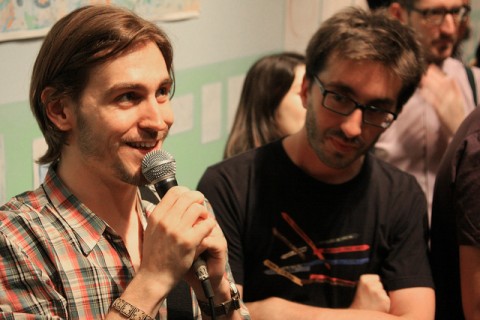
AST co-author, designer and publisher Craig Mod gives a speech about the Kickstarter fundraising that made this second edition a reality.

Naoki Matsuyama and Lena Oishi, who helped with the translation of Art Space Tokyo.
It’s Almost Ready
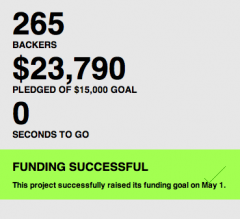 Those of you who followed our Kickstarter.com fundraising campaign in April saw that we ended up climbing to a sum much higher than our original goal of $15,000.
Those of you who followed our Kickstarter.com fundraising campaign in April saw that we ended up climbing to a sum much higher than our original goal of $15,000.
To our amazement, we hit the $15,000 mark after only two weeks, and pledges continued to pour in over the remaining three weeks of the fundraising period.
On May 1, we reached an astonishing total of $23,790, which is allowing us to go ahead with a full second print-run, as well as develop the iPad version.
We are profoundly grateful the 265 backers who made this possible.
Over the past month, Craig and I have been mailing each other back and forth, fixing up a few missteps in the original, and polishing the book’s editorial and design.
The 2010 edition of Art Space Tokyo is at the printers right now and will be with you soon…
Fundraising For Art Space Tokyo Reaches its Goal!
Wow! We have reached our goal of $15,000 in only 16 days!
Craig and I are bowled over by the enthusiasm that people have shown for the Kickstarter project since the page went live on March 29.
We want to extend a HUGE THANK YOU to all of you who have pledged. Your enthusiasm and backing mean a great deal to us.
The project doesn’t close until May 1, so there’s still a chance to join us!
All additional funding we receive will be invested in expanding the second print run, developing an iPad version of the book with supplementary content, and potentially starting work on guides to art scenes in other cities around the world.
If you haven’t already, please join us!
Art Space Tokyo Reprint, Update and iPad!
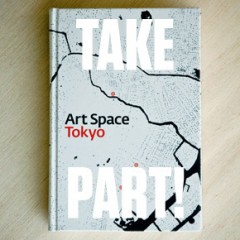 Art Space Tokyo will be back on the shelves, in your hands, and on your iPad soon!
Art Space Tokyo will be back on the shelves, in your hands, and on your iPad soon!
The book’s original print-run of 1,500 copies has been sold out for more than a year. If you’re one of our loyal followers who is frustrated not to have gotten hold of a copy, then this is your chance.
Demand has remained very high, so we bought back the copyright and are reprinting it ourselves, also with plans to develop an iPad version.
We have set up an Art Space Tokyo Kickstarter page, where you can pre-order your copy of the new edition.
Even though this page has only been up for less than a week, and Craig and I haven’t even sent out a mass e-mail about it yet, the response has been incredible.
Just by posting news of the reprint on Facebook and Twitter, as well as some coverage on a couple of popular blogs, we have already raised over $5,000!
This is an experiment in community-funded publishing. If we cannot secure $15,000 in pre-orders by May 1st, printing will not go ahead and you will not be charged. You’re only charged if we raise enough interest and reach our minimum goal.
We hope you’re as excited about this as we are, and that you will continue to give your support to Art Space Tokyo.
Art Space Tokyo in 2010
This is running a little late maybe, but Happy New Year!
Where to in 2010?
The Art Space Tokyo blog was less dynamic in 2009 than I would have liked. My move from Tokyo to New York in January last year meant that I’ve had to run it as a bit of a skeleton service since then. I haven’t had the time to post weekly updates on art in Tokyo, so the best I could do was to keep compiling the monthly round-ups of links to exhibition reviews, artist interviews and feature articles.
These long lists of links may not be the most exciting things to receive on your RSS feed, but I think that in the long term this archiving of the main sources of information on the Tokyo art scene is a useful project, and one that isn’t being undertaken anywhere else.
In any case, Craig and I are working on new developments for AST in 2010, details of which we will bring to you over the next couple of months.
Until then, thank you for keeping your eye on AST, and please stay tuned for more!
AIGA/NY Apple Store talk this Wednesday (Oct. 8th)

Apple Store, SOHO, Manhattan: Wednesday, October 8th, 6:30 - 8:00pm
Just a quick note to let you know I’ll be speaking about the design and production (among other things) of Art Space Tokyo at the Apple Store in SOHO this coming Wednesday (Oct. 8th, 2008) evening.
I’ll be talking about books, design, the creative process, finding time to work on passion projects and other topics, all within the context of living in Tokyo.
It’s a free event and should be quite interesting—pop by if you’re in the ‘hood!
NY Launch Wrapup
A big thank you to all who attended our event last week at Kinokuniya in NYC! It’s hard to believe a week has already passed since our official US launch of Art Space Tokyo. Turnout was better than expected. All seats were full and people were snaking around the back of the room and into the adjacent cafe. A large contingency of the New York art world, designers, artists and others interested in Japanese culture were in attendance.
It wouldn’t have been a success without the great panel we had that night: comprised of Roland Kelts (Japanamerica), Reiko Tomii and Kosuke Fujitaka (NY/Tokyo Art Beat). I’ve been to many a talk with panels than grossly ran over on time, had little focus or just sounded like a bunch of people talking over one another. In stark contrast to that, I think we were able to achieve a focused and concise look at the Tokyo art world. And Reiko even managed to plunge historical contexts in reference to the contemporary. Thanks to the diversity of the panelists, those in attendance got to hear three very different, but equally informed voices. Truly a special event that wouldn’t have been possible without the kindness of John Fuller at Kinokuniya for lending the space and equipment.
So this marks a somewhat sad moment for us here — with this event we officially complete the conception, production and launching of Art Space Tokyo. It’s strange, after working on something for so long and so hard, having planned these events months in advance, to finally arrive at the ‘finish line’ (so to speak) feels very much like having completed a mental (and very much physical) marathon. And as anyone who has trained for an finished a marathon knows, there’s a tinge of sadness in the triumph of achieving your goal.
Of course we’ll still be blogging about the Tokyo art world here, and we’ll be putting on more events and speaking at more bookshops. But the ‘official’ timetable, the schedule we had been working off for the past year or so, is done. Thank you all who helped make this book a success thus far! We look forward to seeing where this project leads us next.
Art Map #7 - SCAI The Bathhouse - Yanaka
SCAI is located in one of my personal favorite areas of Tokyo. Yanaka is in all the guidebooks but it’s often overlooked in favor of the glitz of Shibuya or the moral dubiosity of Shinjuku.
Yanaka is a romantic’s Tokyo: low lying, temple filled, spiritual, wooden, old, textured, musty, comfortable, friendly, slow, delicious ... these are some words you could use to describe the area. Mainly, I love the excellent Japanese food (100+ year old senbei shops and superb soba) and the easy going mood. Visiting for a few hours is like a tonic to the rat race of the rest of the city. Many a great day can be had in the Yanaka area if you’re simply looking to whittle away a sunny afternoon. And SCAI, sitting in the middle of it all, is a great stop along the way.
Don’t forget to grab the PDF map.
Takahashi Vs. Kinokuniya NYC
From September 15th until October 1st, Kinokuniya at Bryant Park, Manhattan, will be hosting a small exhibition of Art Space Tokyo illustrator Takahashi Nobumasa’s work.
Above is an image of the preparations in the secret back offices of Kinokuniya, which, despite being located in the heart of New York City, instantly transports you into a Japanese Office Space—otsukaresamadeshita and all.
Of course, this is in preparation for our big launch event / contemporary art symposium being held next Tuesday, the 23rd from 6:00pm. If you’re in the city, be sure to stop by—it should be a blast. We’ll have some of Takahashi’s prints and tenugui on sale. We’ll also have a healthy supply of books, so those looking to pick up their copy and get it signed shall be satiated.
Details:
Location: Kinokuniya Bryant Park (40th Street and 6th Ave, Manhattan. Closest station: 42nd street Bryant Park)
Dates: From September 15th to October 1st
CMP at the Brooklyn Book Festival
Craig and I were at the Brooklyn Book Festival all day yesterday, thankful that our stand was just in the shade of some very tall trees on an unusually hot day for New York.
It was great to meet fans of Chin Music Press and it was particularly rewarding to witness first hand so many people discovering Art Space Tokyo and the rest of CMP’s publications… there was unanimous praise for the quality of production! We’re looking forward to seeing many of you join us for the talk at Kinokuniya on the 23rd.
As Craig previously announced, last week we were guest bloggers for Powell’s Books. You can read our posts for Monday, Tuesday, Wednesday, Thursday and Friday.
Art Space Tokyo VS September 2008
This is just a quick list of Art Space Tokyo related events Ashley and I are participating in this September:
- Starting Monday, September 8th, Ash and I will be guest blogging for a week over at Powell’s, the blog of the lovable, amazing Portland, Oregon based book shop of the same name.
- September 14th find us manning a booth at the Brooklyn Book Festival. Stop by and say, “Hi!” We’ll also have some Art Space Tokyo related limited edition Japanese cloth prints on sale.
- September 23rd is our big US launch event at Kinokuniya Bookstore next to Bryant Park in midtown Manhattan. It’s a book launch / Japanese contemporary art symposium and should be a lot of fun. We have an excellent lineup of participants. It’s free and starts at 6:00 PM! More info on our Facebook event page.
We’re very much looking forward to connecting with all you US based book and art lovers. Don’t be shy—feel free to stop by and pick our brains.
Art Map #6 - Gallery Koyanagi, Ginza

In just a few days Ashley and I are off to New York to promote Art Space Tokyo, but more on that later!
This is just a quick post to alert kind readers to the new art map for Gallery Koyanagi just posted, this very moment.
Like most of its peers in Ginza, Gallery Koyanagi is located in a typical, nondescript office building. However, as the elevator doors open on the eighth floor, a sleek, discreetly lit cavern of contemporary art stretches out before you. You are about to step into one of the largest commercial gallery spaces in Tokyo. This is the consummate white cube, and Gallery Koyanagi wears this look better than any other art space in the city.
Nakaochiai Gallery — Art Space Map #5
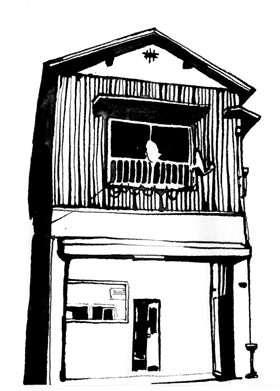 A little overdue, but our latest Art Space Tokyo art map is now up!
A little overdue, but our latest Art Space Tokyo art map is now up!
Nakaochiai Gallery, nestled in a small crook of mid-west Tokyo is one of our book’s most residential spaces. As always, don’t forget to download the high-res PDF version of the map.
We’ve also gone and added Nobumasa Takahashi’s drawings of the art space exteriors to all previous entries.
In related book news, we’re finalizing our September US release New York events and will be posting more information on those soon!
Art Map #2 - Tokyo Gallery + BTAP

What’s that you hear? I believe a new art map is hot off the presses. Download the map file right away, or tuck away the map link for later perusal.
Art Space Tokyo describes Tokyo Gallery + BTAP thusly:
Tokyo Gallery was founded in 1950 by Takashi Yamamoto, the man largely responsible for introducing contemporary art to Japan. As Japan’s first commercial contemporary art gallery, Tokyo Gallery has been at the center of the Tokyo art world for several decades and has continuously exhibited groundbreaking works by Japanese, Asian and Western artists.
Almost everyone knows Ginza but I would venture to say few know this seminal gallery. Tucked away in a back alley near Shinbashi, Tokyo Gallery + BTAP straddles one of those void-like interspaces long time residents of Tokyo know well. To the east lies all the shopping and glamour Ginza has built its reputation on. To the north, a gaggle of upscale hostess clubs; to the west Shinbashi and the Nagakin Capsule Tower, and deep to the south, Tsukiji.
Latest exhibition information and schedules can be found on the Tokyo Gallery + BTAP homepage or their Tokyo Art Beat listing.
Art Space Tokyo in the bookshops
 I’m now back in Tokyo, taking in the whirlwind of activity that was the last ten days in New York.
I’m now back in Tokyo, taking in the whirlwind of activity that was the last ten days in New York.
When comparing the New York and Tokyo art scenes, aside from the larger number and size of galleries in New York, the key difference would be how NY has such distinct art areas, be it Chelsea, Soho, the Upper East Side, the Lower East Side or Williamsburg. With so many galleries concentrated into each of these areas, it is so easy to walk from door to door, from street to street, taking in dozens of shows at a time. In ten days I managed to see some sixty or so exhibitions!
Given how dispersed the galleries are in Tokyo, to do the same in here would be a physically exhausting feat, as Craig and I found out when we were doing our research for Art Space Tokyo last year. The pace of the gallery going experience in Tokyo is inherently different: although we marked other nearby galleries on the maps for each of the twelve spaces in AST, visiting these spaces is really about enjoying the charms of the surrounding area rather than just packing in exhibition after exhibition.
I’m pleased to see that Art Space Tokyo is now in Tokyo’s bookshops. Walking around Roppongi yesterday, I found it in the Tsutaya Roppongi Hills bookshop, the Roppongi Hills Art and Design Store in the Mori Art Museum and the SFT Store in the National Art Center. More outlets are listed here.
Checking out the New York art scene

Craig and I are finally in New York, getting our heads around all the exciting exhibitions and events taking place!
The first thing you cannot help but realize during an afternoon’s walk in Chelsea is how vast the galleries are compared to Tokyo. It feels like you could fit most of Tokyo’s major galleries inside David Zwirner’s cavernous space on W19th Street!
Differences aside, New York’s enthusiasm for Japanese contemporary art can be clearly felt as there are a number of related exhibitions on at the moment. Yoko Ono is having a solo show at Galerie Lelong; “Heavy Light”, a group show looking at contemporary Japanese photography is opening at the ICP this week; SANAA, the architects of the New Museum of Contemporary Art are showing the last ten years of their work in the same museum; and of course, Takashi Murakami is holding his colossal retrospective at the Brooklyn Museum.
The Japanese presence in NY just got a little stronger only a couple of weeks ago, when Tokyo Art Beat, the bilingual art listings website, finally launched New York Art Beat. It’s proving very useful for navigating this city…
artspacetokyo.com renewal and shanghai invasion
Tokyo launch party? Check. Pechakucha presentation in Japanese? Check. Refresh a website for a book with more information and detail than is necessary? Check.
Starting tomorrow our gaze shifts to our September US publication date. We’ll be posting updates, news and event information related to the book (and also some art events in Tokyo) as we travel down the twisted and horribly unpredictable road of public relations and marketing. Wish us luck, kind readers.
Photo: ART SPACE TOKYO in Shanghai — one of our on the ground Chinese agents helped not only smuggle the book into the country, but also get it into one of our favorite French Concession cafes.
About & Community
A place to keep abreast of Art Space Tokyo related news, reviews, events and updates.
Art Space Tokyo is a 272 page guide to the Tokyo art world produced and published by Craig Mod & PRE/POST.
It was originally published in 2008 by Chin Music Press.
Current Tokyo exhibitions
Powered by Tokyo Art Beat
